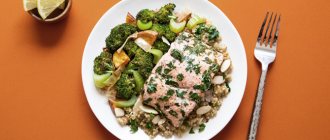The Nordic diet is a specific style of eating that is a bit like the Mediterranean diet. The main menu is based on the consumption of large amounts of fish, lean meat, cereals, as well as vegetables and berries.
And although the list of products that are recommended for recreating the Nordic menu cannot be called diverse, you definitely won’t have to experience the pangs of hunger - the nutritional value of sea fish varieties has long been proven by scientists. Of course, you shouldn’t expect rapid weight loss, but such a diet is consistent with the tenets of proper nutrition, so along with getting rid of 3-5 extra kg per month, you can improve your body’s health without restrictions or deprivations.
Mistakes of other diets
Most diets focus on a single goal - a rapid reduction in weight and volume. At the same time, paying little attention to the general condition of those who use these diets. Many even warn that dizziness and weakness are possible, without considering this a consequence of a serious health problem. In addition, the use of the rules of many diets in everyday life is complicated by other inconveniences:
- The main thing is to lose weight;
- A fasting diet is a mandatory condition of the diet;
- Lose a lot of weight in a short time;
- It is necessary to accurately calculate calories;
- You need to weigh the food for each serving.
Quickly losing 20-25 kilograms on such diets, Susie soon regained completely her previous weight and gained more on top. In addition, due to the lack of nutrients, the condition of the skin deteriorated, its color changed, becoming grayish-pale, hair fell out and headaches, and all the time was spent on complex calculations of calorie content and weight of products.
Having realized that strict restrictions lead to overeating and worsen overall health, she developed a simple, accessible system with which she lost 40 kilograms in 10 months and over the past six years the weight has remained stable, and Susie Wengel looks like a young, healthy, successful woman.
Application in medicine
The Scandinavian diet is used not only for weight loss, but also has indications in medicine. Research by Norwegian scientists has shown that its use gives good results in the treatment of arthritis and normalization of blood pressure. Unlike a regular diet for weight loss, the therapeutic “Scandinavian” is more stringent and consists of several stages with different diets:
Stage one of the diet - low-calorie
Duration: 7-10 days.
Permitted for use:
- herbal teas (the list of herbs is determined by the attending physician);
- beetroot, carrot juice. Attention! Fresh beets should not be consumed immediately. It should sit in the refrigerator for 1.5-2 hours;
- rosehip decoction;
- vegetable broths, soups;
- decoction of parsley seeds;
- mashed potatoes.
It is prohibited to use:
- black, green tea;
- coffee;
- fruit juices;
- meat;
- milk and dairy products (including fermented milk);
- bread, cereals;
- eggs;
- semi-finished products, fast food;
- alcohol;
- rafinated sugar;
- fish;
- fried, spicy, fatty.
Stage two
Duration: 3-3.5 months.
The following are added to the permitted products from the first stage:
- vegetables (almost all);
- berries;
- fruits (except citrus fruits);
- spices in limited quantities: balsamic vinegar, mustard, salt, horseradish (the possibility of their use is discussed with your doctor);
- rice;
- nuts;
- rapeseed oil.
Third stage
The duration is determined by the doctor, but usually it is a year and a half.
To the products of stage No. 2 are added:
- fermented milk products (kefir, yogurt, cottage cheese, fermented baked milk, yoghurts);
- hard cheeses;
- cereals;
- eggs (maximum 3 pieces per week);
- beef, poultry, rabbit.
During the course, it is mandatory to take multivitamins, which must contain vitamins C and E, as well as minerals.
Dietary treatment cannot be prescribed independently! Be sure to consult your doctor and get examined.
Patients using this Scandinavian method of healing noted a decrease in pain, normalization of blood pressure, relief of ulcerative lesions, and weight loss.
Three pillars of the Scandinavian diet
- Local products. The diet includes products that correspond to the nature of the region where a person lives. From a biological point of view, this is healthier than exotic products.
- Easy to measure. Your own fist is used as a measure for 1 serving, which provides the most convenient and accessible way for everyone to determine a single amount of food.
- Maintaining your usual diet. There is no need to give up your favorite foods or go hungry. Because a well-balanced Scandinavian diet is essentially a healthy diet.
See the same topic: Negative and positive qualities of corn flakes for weight loss
Product calculation
— Using the Scandinavian diet for weight loss, you can lose 0.5-1.5 kilograms in 7 days, depending on your initial weight and individual metabolic characteristics.
— One meal includes 4 servings of foods containing mainly:
- Protein - 1 serving;
- Simple carbohydrates - 1 serving;
- Vegetables - 2 servings;
- 50 g, or 1 tablespoon, fat.
— Such a convenient system eliminates the need to weigh foods or go crazy with complex calorie calculations.
— The calorie content of the diet for women is 1500 kcal/day, for men — 2000 kcal/day.
A more accurate idea of what this dietary nutrition system actually looks like is given by an example of a menu for one day:
In the morning
- 1 serving of protein - 2 eggs;
- 2 servings of vegetables - green peas and ripe tomatoes;
- 1 serving of carbohydrates - rye/bran/grain bread;
- 1 tbsp. l. fats - butter;
- Liquid - coffee latte.

2 eggs

Peas and tomatoes
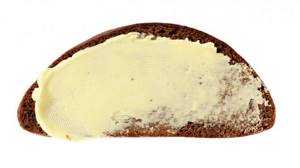
Cereal bread and butter

At lunch
- 1 serving of protein - 1 egg + piece of ham;
- 2 servings of vegetables - mushrooms, bell peppers, carrots, onions, garlic, cherry tomatoes;
- 1 serving of carbohydrates - rye/bran/grain bread;
- 1 tbsp. l. fat - a piece of cheese;
- The liquid is a cup of tea.
In the evening
- 1 serving of protein - meat cutlet;
- 2 servings of vegetables - carrots, asparagus, parsnips;
- 1 serving of carbohydrates - dry red wine;
- 1 tbsp. l. fats - oil for frying vegetables, sauce for cutlets.
Based on this menu and the proposed list of products, it is easy to create a suitable diet for every day and make this nutritional system a way of life.
Menu for the week
When planning a menu for the week, it is important to consider calorie content and their compatibility. A sample menu for the week might look like this.
Monday
- for breakfast - an omelet with spinach or with cheese and peas, topped with bran bread (1 slice);
- before lunch you can have a snack with fresh vegetable salad and a glass of low-fat kefir;
- for lunch it is optimal to eat chicken soup, chopped vegetables and rye bread;
- afternoon snack - dried fruits;
- for dinner - fish baked with vegetables;
- Before going to bed, you can drink green tea with honey (1 tsp) and a slice of bran bread with butter.
Tuesday
- for breakfast - fruit salad with kefir;
- before the lunch break you can eat a boiled egg with lettuce, seasoned with sauce;
- for lunch - fish or chicken cutlet with sauce, chopped vegetables and rye bread;
- afternoon snack - a glass of fermented baked milk or low-fat kefir;
- for dinner - cabbage rolls with minced turkey, stewed vegetables seasoned with low-fat sauce;
- before bed - warm milk with honey and cinnamon.
Wednesday
- for breakfast - boiled eggs (2 pcs.), cherry tomatoes, fresh herbs and cucumbers;
- before lunch you can drink a cup of coffee without sugar, eat a sandwich of rye bread with cheese;
- for lunch it is recommended to eat steamed fish, supplemented with boiled green beans and bran bread;
- for an afternoon snack - fresh or frozen berries with low-fat yogurt;
- for dinner - pumpkin soup with boiled lean meat and dried bread;
- 3 hours before bedtime - cocoa with milk.
Thursday
- breakfast - low-fat cottage cheese, seasoned with fresh herbs and chopped vegetables;
- before the lunch break you can drink tea flavored with raisins and prunes;
- at lunchtime you can cook a steak from lean veal, which is seasoned with mustard and eaten with bread;
- for an afternoon snack - low-fat kefir, supplemented with fresh berries (lingonberries, cranberries);
- for dinner - turkey with lentils;
- before bed - a decoction of herbs or green tea with lemon juice and honey.
Friday
- for breakfast - 1 egg omelet with chopped mushrooms and tomatoes;
- before lunch you can eat toasted rye bread with a slice of cheese;
- at lunchtime - chicken meatballs seasoned with cream sauce, shredded cabbage salad seasoned with a mixture of vinegar and olive oil;
- afternoon snack - fruit juice;
- for dinner they prepare a dish of red fish with spices and lemon juice, beet salad with low-fat sour cream and garlic;
- Before going to bed, drink warmed milk with 1 tsp. honey and cinnamon.
Saturday
- for breakfast - buckwheat porridge with milk;
- before lunch - a vegetable salad, dried with bread and butter and a hard-boiled egg;
- for lunch - tomato soup with croutons and ham;
- afternoon snack - curdled milk with apple;
- for dinner - grilled cutlet, baked vegetables with hard cheese;
- before bed - tea with honey (1 tsp) and lemon juice.
Sunday
- breakfast - apple with cinnamon, cooked in the oven;
- during the break before lunch - cottage cheese with herbs and vegetables;
- for lunch - risotto with vegetables and mushrooms;
- a fruit mixture with yogurt or kefir is suitable as an afternoon snack;
- for dinner - boiled chicken fillet with daikon;
- before bed - herbal tea with 1 tsp. honey
Recommended Products
This is the main set of products characteristic of the Scandinavian countries. The rules of dietetics provide for the replacement of imported wonders with similar local products, but without sometimes prohibiting the consumption of original dishes.
- Sea fish and seafood. Replaced with river varieties of fish with the addition of products with Omega 3, Omega 6 (olive, flaxseed oil, fish oil, lard). Dishes from various varieties of fish are included in the menu every other day, or 3-4 times a week.
- Game meat (elk, venison). Replaced with lean beef, turkey, dietary rabbit, chicken and any other types of farm-produced meat or game.
- Berries. In season - fresh, in winter frozen or ground with sugar. During the year, you need to eat 3-4 kilograms of berries of each type growing in your area of residence.
- Vegetables. All surrounding species plus grasses.
- Cereals. In the country of the author of the diet, the range of cereals is limited to rye, wheat, barley and brown rice. Therefore, the diet contains a lot of muesli, bread, cereal and similar products. Replaced with a variety of bread products, porridges made from whole grain cereals. A third of the diet consists of fiber-rich foods.
- Mushrooms. A delicious, hearty product that grows in all regions.
- Nuts. Rich in folic acid, copper, selenium, healthy fats and other microelements, walnuts, almonds, cashews, Brazil nuts, hazelnuts, pine nuts, and peanuts will perfectly complement any diet.
- Vegetable oil. The Scandinavian diet includes rapeseed oil, but this is not essential; any vegetable analogue can be an alternative.
- Dairy products 1.5% fat. They make up 30% of the diet. These are cheeses, cottage cheese, fermented milk products, yoghurts, milk.
See the same topic: Tomato juice diet activates metabolism
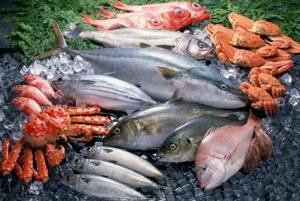
Sea fish
Despite its simplicity, the Scandinavian healthy eating system also introduces certain restrictions.
History of discovery
The author of the Scandinavian diet is considered to be Danish Susie Wengel, director of a biotechnology company and nutritionist.
This woman dreamed of losing weight and developed a special nutrition system for herself. By sticking to it, Susie was able to lose 40 kg. excess weight from the initial 100, and maintain the achieved result for many years. Based on her weight loss experience, the woman published a book.

However, the Scandinavian system of healthy eating takes its roots from a large-scale experiment conducted in northern Karelia (Finland) in the early 60s of this century.
This period marks the peak of cardiovascular diseases in Europe and, in order to prevent them, Finnish doctors are beginning to promote among the population the consumption of rapeseed and vegetable oils instead of butter, fish and lean beef instead of pork.
And bring an abundance of berries, fruits and herbs to any public catering outlet.
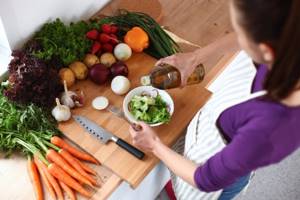
Scientists are also changing the diet of cattle in order to reduce the fat content of the milk and meat they produce. The result of such actions at the government level is a 7-fold reduction in mortality from heart and vascular diseases.
The principles of the Scandinavian diet appeared thanks to the communication of five famous chefs from the Nordic countries at a culinary seminar in Copenhagen (2004).

Combining historical and personal experience of Icelandic, Danish, Swedish, Finnish and Norwegian food, restaurant gourmets, led by the legendary chef Klaus Mayer, formulated the main provisions of the movement for a new server kitchen.
Their manifesto stated that the basis of a healthy and tasty diet lies in:
- in simplicity, freshness, aesthetics and purity of native traditions;
- observing the seasonality of product use;
- in search of the best combinations of natural flavors with modern innovations in the culinary arts;
- avoiding modified additives, flavor enhancers and aggressive preservatives.
All these ideas are still followed in the famous restaurant Noma , located in the center of Copenhagen, which was recognized as the best in the world in 2010, 2911, 2012 and 2014.
Principles of the Scandinavian diet
Basic rules of healthy eating according to Susie Wengel:
- During weight loss, the following should be excluded from the diet: strong alcohol, beer, baked goods, pasta, fast food, sweet carbonated drinks and other excessively fatty, sweet and “harmful” foods.
- Preserve vitamins and nutrients as much as possible. That is, try not to heat anything that can be consumed raw.
- Reduce to microdoses or completely eliminate salt and other artificial flavor enhancers. Replace with natural spices, lemon juice and aromatic herbs.
- It is advisable to get rid of bad habits.
To make it easier for beginners to navigate, we present a diet option for 7 days.
Recipes
The Scandinavian diet creates ideal conditions for lovers of culinary experiments, because many tasty and healthy dishes can be prepared from the products allowed on it. If you are used to preparing food strictly according to a prescribed recipe, you can find a large number of step-by-step instructions on the Internet for preparing dishes suitable for the Norwegian type of diet. Below you will find the most interesting and original recipes.
Finnish cabbage soup
- Time: 2 hours 15 minutes.
- Number of servings: 6 persons.
- Calorie content of the dish: 26.7 kcal per 100 grams.
- Purpose: for lunch.
- Cuisine: dietary.
- Difficulty: easy.
One of the most popular first dishes in northern European countries is Finnish cabbage soup. The peculiarity of this soup is that it is prepared without potatoes, therefore it contains a minimum of calories. To prevent the cabbage soup from turning out too sour, soak the cabbage for half an hour in clean cold water before adding it to the broth. Aromatic spices and pieces of fresh paprika will help give the first dish a rich aroma and piquant taste, which will also make the soup bright and appetizing.
Ingredients:
- lean beef on the bone – 420 g;
- sauerkraut – 600 g;
- sweet bell pepper – 2 pcs.;
- tomato paste – 3 tbsp;
- large carrots – 1 pc.;
- black pepper and allspice peas – 4 pcs.;
- bay leaf – 1–2 pcs.;
- salt, fresh herbs - to taste.
Cooking method:
- Peel the carrots and grate them onto a coarse grater. Remove bell peppers from stalks and seed pods and cut into large cubes.
- Rinse the meat under running water, place in a saucepan, add spices, add two liters of cold water, and put on high heat.
- After boiling, reduce heat to medium and skim off any foam that forms on the surface of the broth. Cook for 20-30 minutes.
- Place washed sauerkraut, grated carrots, and pieces of paprika into a saucepan with soup. Cook for an hour.
- Then remove the meat, separate it from the bone, cut it into pieces and return it to the cabbage soup. Salt the soup to taste, add tomato paste, boil for another 4-5 minutes.
- Before serving, sprinkle the cabbage soup with chopped herbs.
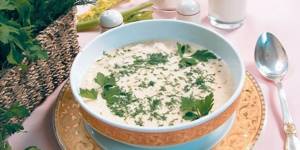
Risotto with mushrooms
- Time: 55 minutes.
- Number of servings: 4 persons.
- Calorie content of the dish: 138.4 kcal per 100 grams.
- Purpose: for lunch, dinner.
- Cuisine: dietary.
- Difficulty: easy.
A good alternative to the usual pilaf is aromatic risotto with mushrooms. Any wild mushrooms or store-bought oyster mushrooms or champignons are suitable for this dish. It is better to take brown rice for risotto - it contains less starch, so the finished dish will be low in calories, but at the same time tasty and healthy. A scattering of emerald green onions, slices of tomatoes and a little canned corn will help add some bright colors to the mushroom risotto.
Ingredients:
- brown rice – 240 g;
- any mushrooms – 380 g;
- garlic – 3-4 cloves;
- large tomato – 1 pc.;
- green onions - a bunch;
- fresh parsley - a bunch;
- canned corn – 2 tbsp;
- boiled yolk – 2 pcs.;
- fresh dill - to taste;
- salt, spices - to taste.
Cooking method:
- Rinse the cereal several times under running water, transfer it to a saucepan, add clean water so that the liquid is 2-2.5 cm higher than the rice.
- Place over high heat, bring to a boil, add 0.5 tbsp. salt, mix. Reduce heat to low, simmer for 10-15 minutes.
- Then turn off the heat and leave the rice to swell on the hot stove.
- Wash the mushrooms, dry them, cut into thin slices.
- Peel the garlic and crush it with a knife. Chop the parsley.
- Finely chop the green onions. Pour boiling water over the tomato, remove the skin, cut the pulp into small cubes.
- In a frying pan with a little olive oil, fry the mushrooms with garlic and parsley, add the chopped tomato, and fry a little more.
- Add boiled rice to the mushroom base, add 50-60 ml of water, simmer over medium heat for 10 minutes.
- Turn off the heat, add chopped green onions and canned corn, mix thoroughly.
- Before serving, sprinkle the dish with grated boiled yolk and chopped dill.
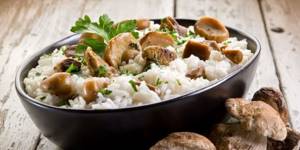
Chicken with Jerusalem artichoke
- Time: 1 hour 10 minutes.
- Number of servings: 6 persons.
- Calorie content of the dish: 123.9 kcal per 100 grams.
- Purpose: for lunch, dinner.
- Cuisine: dietary.
- Difficulty: easy.
You can prepare a complete dietary dish of meat and vegetables using chicken. To make the finished dish less caloric, it is advisable to replace the potatoes with Jerusalem artichoke tubers. This simple root vegetable will help make dinner not only tasty, but also healthy. Please note that when cleaning Jerusalem artichoke, a lot of waste remains because it has a very rough skin, so take the product with a large supply.
Ingredients:
- whole chicken – 1 pc.;
- peeled Jerusalem artichoke – 300-330 g;
- carrots – 2 pcs.;
- garlic – 4-5 cloves;
- Provençal herbs – 1 tbsp;
- celery stalks – 2 pcs.;
- lemon juice – 1 tbsp;
- fresh ginger - a piece;
- salt - to taste.
Cooking method:
- Cut the peeled Jerusalem artichoke and carrots into thin slices, place on the bottom of a baking dish, add salt, sprinkle with vegetable oil, and cover completely with water.
- Peel the garlic and ginger root and chop with a grater. Chop the celery finely.
- Mix chopped garlic, ginger, celery, lemon juice, Provençal herbs and a little salt in a mortar and grind into a homogeneous mass.
- Rub the resulting seasoning onto the chicken and place on a vegetable bed.
- Bake in an oven preheated to 180° until cooked (40-45 minutes).
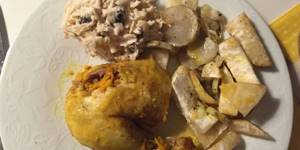
Pros of the Scandinavian diet
The advantages of this diet are based on correcting the mistakes of other weight loss systems:
- The main thing here is not to lose as many kilograms as possible, but to gradually lose weight, maintain and improve your health;
- Lack of constant feeling of hunger;
- A gradual decrease in volume, which allows the skin to tighten in a timely manner, subject to sufficient physical activity;
- Convenient calculation of diet and daily portions of food according to the rule of four servings;
- Availability and interchangeability of products, which allows you to adapt the diet to any geographical area;
- Prolonged weight stabilization.
After reducing the volume to the desired value, after some time you can remove strict restrictions on a number of products (bananas, grapes, pastries) and continue to eat according to the Scandinavian type throughout your entire life, observing the basic rules for the quantity and combination of ingredients.
Reviews and results
Opinions of those losing weight:
Maria, 48 years old:
I have tried many methods to lose weight. But sometimes this is a difficult test for health. But the Scandinavian version worked great - this diet also has medicinal properties. My cholesterol has returned to normal, and my general health is simply wonderful. And, the main thing in this method is that all products are available in any store, and in the summer the diet is replenished with the summer harvest.
The only thing is that rapeseed oil is difficult to find, but I replaced it with unrefined sunflower and mustard oil.
Artem, 35 years old:
My doctor suggested that I follow the Scandinavian diet as an additional method of treating obesity. For a week I “suffered” - I had a craving for sweets. But, on the doctor’s recommendation, in such situations I replaced it with apples and berries. Then I got used to it and even began to enjoy it; the tastes of many dishes revealed themselves in a new way. I gained weight quite well, 6 kg in a month. In general, I think I’ll always stick to this diet, because my stomach and intestines have started to work better, and I’ve also become more physically active.




